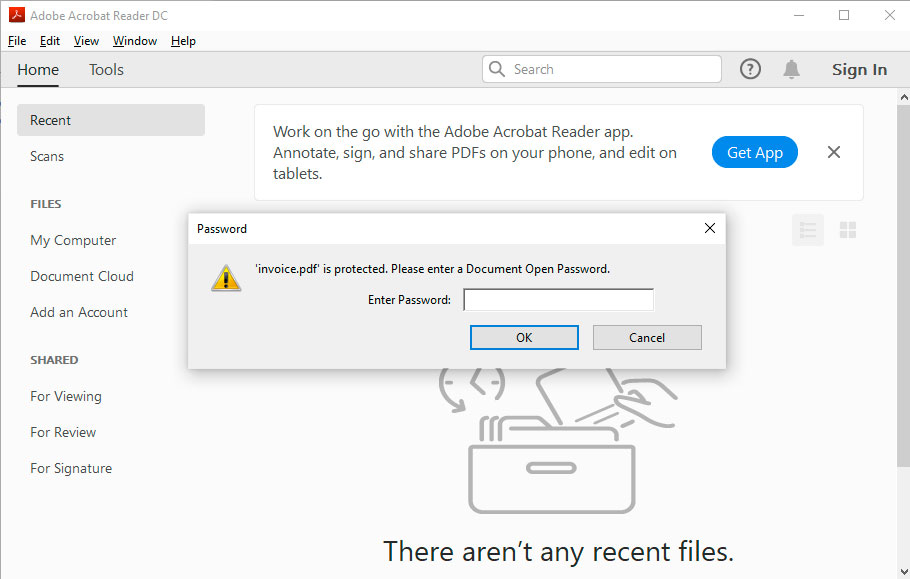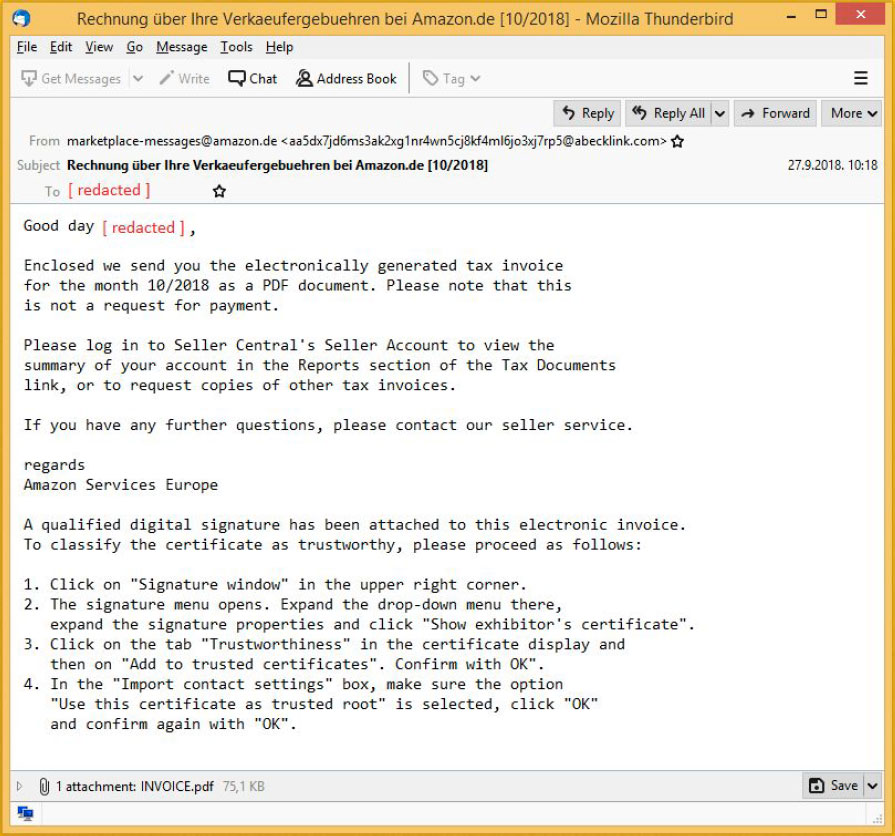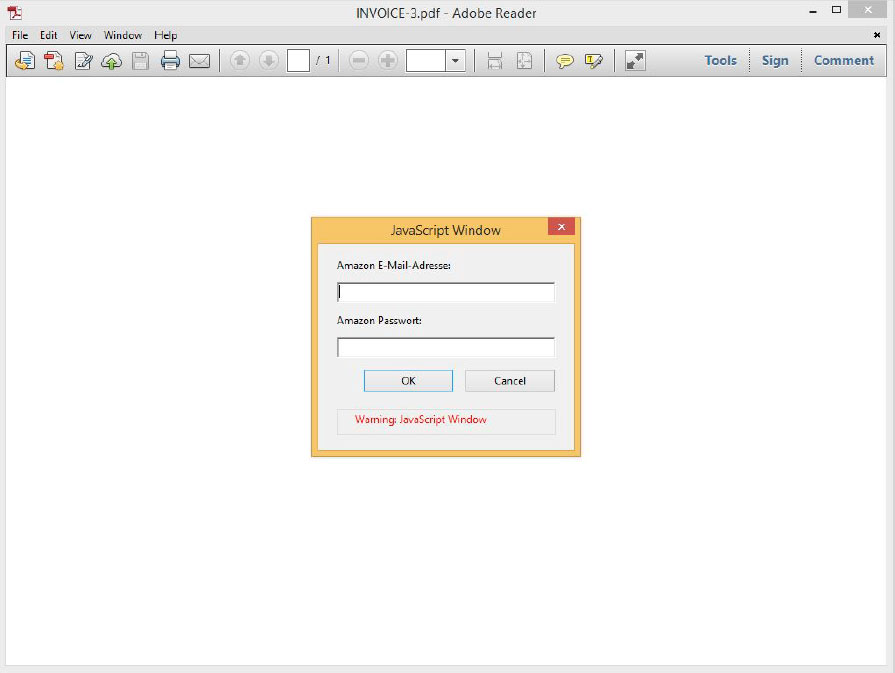
The goal of any phishing scam is to make you do something you shouldn’t do. Such is the case with a phishing campaign that utilizes PDF attachments that display login prompts that to many would look legitimate.
If you are a regular reader of BleepingComputer, you know that we like to highlight interesting phishing scams that our readers may encounter. This is to make them aware of them so they don’t fall for scams that stand out from the rest.
Such is the case with the latest phishing campaign found by detection company ReversingLabs and shared with BleepingComputer prior to publication.
What makes this scam stand out is that instead of using fake landing pages, it instead uses fake JavaScript login forms generated directly by the the PDF attachment.
“One such vector that might be overlooked is credential theft via JavaScript-enabled documents,” stated the researchers in their report. “This attack technique doesn’t rely on malicious links or domain spoofing, but on document scripts that yield the same effect”
Tax documents are commonly self-protect with login prompts
If you routinely send tax documents via email for your business, you are probably familiar with password protected PDF documents that are used to protect sensitive tax information.

In this scam targeting German victims, the scammers pretend to be sending you a tax invoice from Amazon and specifically state that you will need to login to your Amazon Seller’s account to view the tax invoice.

If you open the attached PDF file you will be shown a fake login prompt, created using JavaScript, that asks for your Amazon email address and password. Because its a tax document and they specifically stated that a user would have to login to view it, some users may think this is a legitimate request and enter their login credentials.
“The document is asking the reader to log in so they can see the sent tax records. As explained in the email, this screen is to be expected, and typing the credentials into it will show the account summary information. Unusual as it may be, an unvigilant reader might brush it off as a security feature designed to keep their private information safe. But what’s going on behind the scenes?” the researchers explain.

In reality, though, this login prompt is being shown by a JavaScript script that will instead submit any submitted credentials to a long URL located at the http://sellercentral.amazon.de.56U8GTHDGT4U7YWEWE84GTYS.abecklink., which is obviously not the legitimate http://sellercentral.amazon.de.

Once the credentials are entered, the attackers will now have full access to your Amazon account and be able to use it as if they were the legitimate owner.
Protecting yourself from this type of scam
For Phishing scams we normally tell you to examine the URL of any landing pages to make sure they look legitimate. We also advise you to only login to sites at their official domains, rather than through one linked by an attachment.
In this case, the login prompt is being generated to open a protected PDF document, no URLs are being displayed, and you were told that this would happen.
This is why in addition to checking the landing page URLs you always need to check the sender to make sure they match up with a legitimate domain and one that corresponds with the email you received.
When it comes to tax documents, you should be even more vigilant and reach out to the sender to confirm they sent you sensitive information via email.
Related Articles:
Beware of Emails Asking You to “Confirm Your Unsubscribe” Request
Scammer Arrested After Defrauding US Universities of Over $870K
North Carolina County Lost $1.7 Million in BEC Scam
Twitter Can be Tricked Into Showing Misleading Embedded Links
Bleeping Computer® is a community of individuals of all ages who are here to learn new information, to help each other, and to help their fellow peers. With that in mind, we ask that all members please follow these simple rules in order to create an atmosphere where everyone feels comfortable.
The rules are as follows:
- All information and instructions given within these forums is to be used at your own risk. By following or using any of this information you give up the right to hold BleepingComputer.com liable for any damages.
- All the forums are categorized by topics. Please post your questions or messages in the appropriate forum.
- Answers to many of the questions you may have can be found in the Tutorials Section, Glossary, or from other posts on the message boards. Please use the search functions, at the top right of each page, to find your answers. If you are still having problems, feel free to post your question.
- All help must be provided in the forums or on our Discord Server. We do not allow support to be provided or requested via personal message, email, or remote desktop control programs (Logmein, TeamViewer, etc).
- If a topic is posted in a forum that is not appropriate for the question, the staff has the right to move that topic to another better suited forum.
- The posting of any copyrighted material on our web site is strictly prohibited.
- Posting links in order to generate affiliate commissions is not permitted at BleepingComputer.com. Any posts that are deemed to be posted in order to generate affiliate commissions, regardless of the product being promoted, will be deleted. If a user continues to create affiliate SPAM posts, they will be banned.
- Posting links to non-Bleeping Computer malware removal guides is NOT permitted with the exception of security vendors who sometimes release specialized tools and instructional documentation. This is because it is impractical for BleepingComputer to monitor and review all such guides for accuracy, no matter how accurate those guides may, in fact, be.
- There will be no use of profanity on our message boards. This will not be tolerated and can lead to immediate suspension.
- When posting, please use proper grammar. Refrain from ‘text-message’ style substitutions of words like ‘u’ for ‘you’, and ‘ur’ for ‘your’. This is a multi-national forum, and some of our non-english speaking members must use translation software which is confused by abbreviations. Most of our volunteer members are very busy helping as many people as they can, and a post that is hard to read will often be overlooked.
- There will be no racial, ethnic, gender based insults or any other personal discriminations. This will not be tolerated and can lead to immediate suspension.
- There will be no posts meant to offend or hurt any other member, in a manner which is offensive or inflammatory. This includes flaming or instigating arguments.
- Spamming is not permitted; please keep all your posts as constructive as possible.
- Pornography, warez, or any other illegal transactions may NOT be linked in any shape or form.
- If you have questions regarding homework, we will only help you with general concepts. If you are looking for a complete solution or answer, we will most likely just delete your post.
- No subject matter will be allowed whose purpose is to defeat existing copyright or security measures. If a user persists and/or the activity is obviously illegal the staff reserves the right to remove such content and/or ban the user. This would also mean encouraging the use or continued use of pirated software is not permitted, and subject to the same consequences.
- If you are receiving assistance in the Virus Removal forum, you are not allowed to request assistance for the same computer at another malware removal forum. This is to prevent conflicting advice from causing issues with your computer or making it unbootable.
- This forum has the right to request alteration or deletion of any offensive post. If this is not done in a prompt manner, the Staff will delete the material themselves.
- Posts may be deleted for any reasons the forum administrators deem reasonable.
- Pictures may be posted as long as they are not explicit, offensive, or copyrighted.
- Advertisements, of any sort, are not permitted. This includes member names and links to commercial sites in Signatures, or in posts. You also may not solicit sales for Newegg through the use of promotion or coupon codes. If you would like to advertise on our site, contact us here.
- In order to reduce spam on the site, you will not be able to add a signature to your account until you reach 25 posts. Signatures are limited to 5 lines or 2000 characters; whichever comes first. If your signature is larger than the allotted size given or deemed unacceptable, you will be requested to adjust your signature. Failure to comply will result in the removal of your signature.
- Only one image per signature. Images in signatures must also be no larger than 500 pixels wide X 90 pixels high. If you have more than one image you will be requested to remove one. If this is not done in a timely manner the staff has the right to modify your signature to abide by these rules.
- Any links in signatures or profiles cannot be commercial in nature or they will be removed by BleepingComputer. You may not put links in your signature soliciting donations unless you are in certain member groups. Those member groups that are allowed will be expressly notified. If you have a personal website or off-site help resource, that is more than fine, but you can not sell products or services through your signature. Multiple links to the same site, unless for a very specific reason, are not permitted in a signature and will be removed.
- Avatars must be in good taste. This means no vulgar or violent images, pornography, or profanity. Avatars that are found to be inappropriate will be removed at the discretion of the staff.
- Linking to hate, anti-Semitic, racist, pornography, warez, or other illegal sites is not permitted.
- Links in your signature must be unobtrusive and can not use formatting so that attention is brought to them.
- Member’s display names can not be email addresses. This rule is in place to protect you from spam bots who will pick up your email address and spam you.
- Members may have only one account on this forum. There is no need to have more than one.
- Any impersonation of a user from these forums, in any mode of communication, is strictly prohibited and will result in a banning.
- Linked and locked topics are pruned regularly to reduce page clutter. If you have a question about where your topic went, please PM a Moderator or Administrator before starting a new topic asking where it went, or posting a duplicate of the original topic. We will be happy to provide you with a link to the new location, or a reason why it was locked and/or removed.
Violation of any of these rules can lead to a banning of the user from our Web Site and a deletion of their account. The consequences will be determined by the Staff on a case by case basis.
When posting you agree that the administrators and the moderators of this forum have the right to modify, delete, edit or close any topic, signature, account, or profile data at any time that they see fit. If you have any questions concerning this, please do not start a new thread, but rather private message to an administrator or moderator.